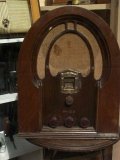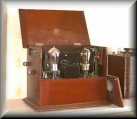Aurality as central to radio theory (and radio drama theory)
The ears have it.
(Alan Beck's term) Part of core theory for radio. 'Aurality', matches film's 'specularity'.
It has three aspects: the 'listening-to-ness' of radio reception, the 'heard-of-ness' of the broadcast speaker and other sound events on radio, and listening in itself.
| It is the monaural medium that makes radio drama aesthetically unique. |
| See Aural Paradise |
| See Oculocentrism or ocularocentrism - dominance of seeing in our senses |
1857 Phonautograph of Édouard-Léon Scott de Martinville
See http://people.deas.harvard.edu/%7Ejones/cscie129/images/snd_vis/snd_vis.html
See also Alexander Graham Bell's Path to the Telephone at http://www3.iath.virginia.edu/albell/homepage.html
Bell's Ear Mental Model. See http://repo-nt.tcc.virginia.edu/book/chap3/chapter3sec7.html
|
Alan Beck: There is what I have newly termed 'aurality', to match film's 'specularity' and painting's 'opticality', noting that radio is a one-modality medium. Aurality has three aspects: (1) the 'listening-to-ness' of radio reception, (2) the 'heard-of-ness' of the broadcast talker or performer and other sound events on radio, and (3) listening in itself: the 'listening that - ' and the 'listening how - '. I link radio's multiple codes of communicating with reception theory and I hope to reverse oculocentrist tendencies (chapter 4), that is the tendency to think and theorize visually about sound. I wish to shift theoretical attention instead to the aural in itself, which has been somewhat neglected in media theory, and theory of the sight/sound media overall. We regularly use 'visualist' metaphors in describing our reception of broadcast radio and indeed, as listeners, we process aural data across sense modalities. In other words, when we listen to radio, we may 'see', 'feel', 'smell' and 'touch' also, in our minds. I consider optic ('visual') and haptic ('touching', with depth
and perspective) aspects of aural processing. In what phenomenologists
have to offer about the human sensorium, I would favour the internalists,
that is, those who do not consider the perceptual array as modular
but as interpenetrating. Aurality is not a unified theory, but
it is inclusive and a centre, and it is a stance towards the
problem of 'What is radio?' - an exploration into multidimensional
phenomena demanding different research projects.
|
|
|



